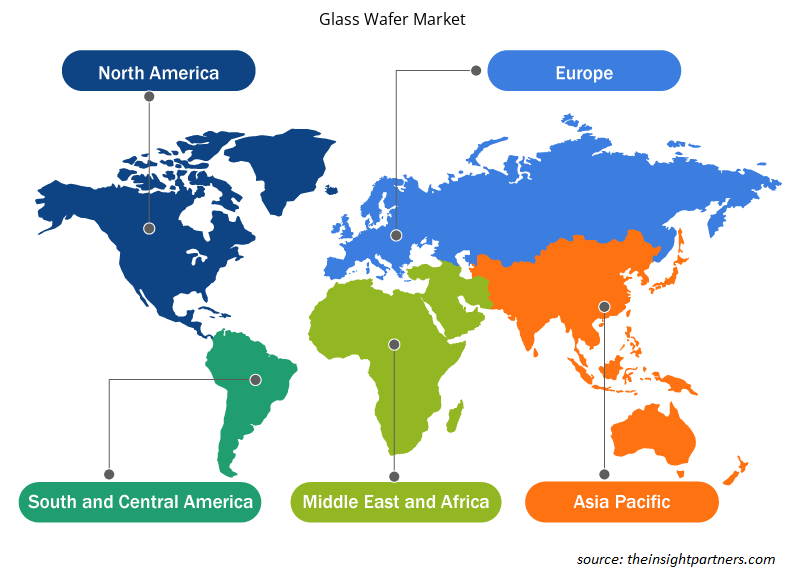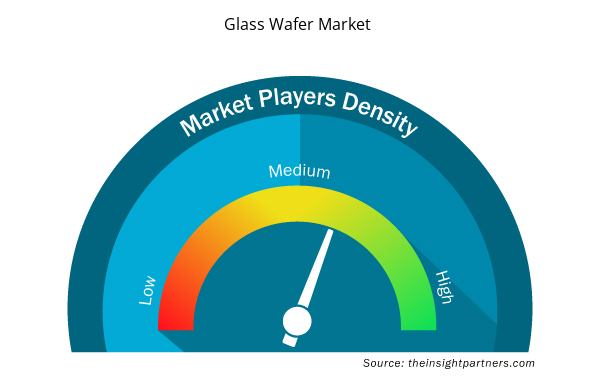2020 年玻璃晶圆市场价值为 2.9548 亿美元,预计到 2028 年将达到 5.7517 亿美元;预计 2020 年至 2028 年的复合年增长率为 8.5%。
玻璃晶圆是一种薄圆盘,用作制造集成电路和保护消费电子产品的基础。玻璃晶圆通常由石英、硼硅酸盐玻璃或熔融石英制成。这些晶圆用于各种工业和技术应用。硼硅酸盐玻璃晶圆对水或任何其他类型的化学物质具有更高的化学稳定性。对紧凑和先进的消费电子设备的需求增加将推动玻璃晶圆市场的增长。由于电动和混合动力汽车,对汽车电子产品的需求增加将导致对玻璃晶圆的需求增加。
2020 年,亚太地区在全球玻璃晶圆市场中占据最大份额。该地区的主导地位主要归因于该地区汽车和电子行业的快速增长。汽车、医疗等工业领域的迅猛增长影响了对玻璃晶圆的需求。亚洲是领先的电气和电子制造地区之一。
2020 年 12 月,武汉首次报告了 COVID-19 疫情。截至 2021 年 1 月,美国、印度、巴西、俄罗斯、法国、英国、土耳其、意大利和西班牙是确诊病例和死亡人数最多的国家。根据 2021 年 1 月更新的最新 WHO 数据,全球确诊病例约 83,322,449 例,死亡人数 1,831,412 例。由于封锁、旅行禁令和企业停工,疫情对各国的经济和行业产生了不利影响。全球化学品和材料行业是遭受严重破坏的主要行业之一,例如供应链中断、技术活动取消和办公室关闭。尽管中国是全球制造业中心和各行业最大的原材料供应国,但它也是受影响最严重的国家之一。中国各工厂的封锁限制了全球供应链,扰乱了制造活动、交货计划以及各种化学品和材料销售。各公司已经宣布产品交付可能延迟,未来产品销售下滑。此外,欧洲、亚洲和北美国家实施的全球旅行禁令阻碍了商业合作和伙伴关系机会。所有这些因素都阻碍了化学品和材料行业的发展,从而抑制了与该行业相关的各个市场的增长。
定制此报告以满足您的需求
您可以免费定制任何报告,包括本报告的部分内容、国家级分析、Excel 数据包,以及为初创企业和大学提供优惠和折扣
- 获取此报告的关键市场趋势。这个免费样品将包括数据分析,从市场趋势到估计和预测。
市场洞察
MEM 需求不断增长
由于微机电系统 (MEMS) 在通信系统、汽车传感器以及便携式医疗设备中的应用,全球对微机电系统 (MEMS) 的需求不断增加。这些 MEM 的微型设计使其适用于所有电子设备,这增加了 MEM 的应用。玻璃晶圆主要用于敏感元件的晶圆封装,因为它们具有出色的功能性、可靠性和承受恶劣环境的能力。这些玻璃晶圆还因其耐化学性和热稳定性而用作载体基板。由于全球卫生工作者的使用和需求增加,对便携式医疗设备(包括患者监测设备)的需求在大流行期间一直在上升。COVID-19 大流行增加了消费者对个人监测设备的需求。这些设备与 MEMS 集成。因此,对 MEM 的需求增加,这反过来又推动了玻璃晶圆市场的增长。Micro-Electro-Mechanical Systems (MEMS) across the world, owing to their applications in communication systems, automotive sensors, as well as portable medical devices. The miniature design of these MEMs makes them a suitable for use in all electronic devices, which has increased the application of MEMs. Glass wafers are mostly used in wafer packaging of sensitive components, owing to their superior functionality, reliability, and capacity to withstand harsh environments. These glass wafers are also used as carrier substrates due to their chemical resistance and thermal stability. The demand for portable medical equipment, which includes patient monitoring devices, has been on the rise during the pandemic, owing to the increased usage and demand by health workers across the world. The COVID-19 pandemic has boosted the demand for personal monitoring devices among the consumers. These devices are integrated with MEMS. Hence, there is an increase in demand for MEMs, which in turn is propelling the growth of the glass wafers market.
应用程序洞察
根据应用,玻璃晶圆市场细分为 CMOS 图像传感器、集成电路 (IC) 封装、LED、微流体、FO-WLP 以及 mems 和 RF。CMOS 图像传感器部分在 2020 年占据了最大的市场份额。图像传感器或成像器是一种检测和传递信息的传感器,用于生成图像。电子图像传感器有两种类型,即电荷耦合器件 (CCD) 和有源像素传感器 (CMOS 传感器)。有源像素传感器是一种图像传感器,其中每个像素传感器都有一个光电探测器。不同类型的有源像素传感器包括早期的 NMOS APS 和常见的互补 MOS(CMOS) APS,后者被称为 CMOS 传感器,广泛应用于数码相机技术和手机中。CMOS 图像传感器具有低功耗、高集成度和快速 IO 读出速度等多种特性,因此它已成为最广泛使用的传感器之一。CMOS image sensor, integrated circuit (IC) packaging, LED, Microfluidics, FO-WLP, and mems and RF. The CMOS image sensor segment led the market with the largest share in 2020. An image sensor or imager is a sensor that detects and conveys information, which are used to make an image. There are two types of electronic image sensors that are charge-coupled device (CCD) and active-pixel sensor (CMOS sensor). Active pixel sensor is an image sensor in which every pixel sensor has a photodetector. Different types of active pixel sensor include the early NMOS APS and the common one that is the complementary MOS(CMOS) APS, which is known as the CMOS sensor, and is widely used in digital camera technologies as well as in cellphones. CMOS image sensor has various properties such as low power consumption, high integration, and fast IO readout speed due to which it has become one of the most widely used sensors.
玻璃晶圆市场的一些主要市场参与者包括 SCHOTT AG、AGC Inc.、康宁公司、Plan Optik AG、信越化学株式会社、Samtec Inc、Bullen、日本电气硝子、Swift glass 和 Coresix Precision Glass, Inc. 市场的主要参与者正专注于并购和产品发布等战略,以扩大全球地理影响力和消费者基础。 SCHOTT AG; AGC Inc.; Corning Incorporated; Plan Optik AG; Shin-Etsu Chemical Co., Ltd; Samtec, Inc; Bullen; Nippon Electric Glass; Swift glass; and Coresix Precision Glass, Inc. Major players in the market are focusing on strategies such as mergers and acquisitions and product launches to expand the geographical presence and consumer base globally.
玻璃晶圆市场区域洞察
Insight Partners 的分析师已详尽解释了预测期内影响玻璃晶圆市场的区域趋势和因素。本节还讨论了北美、欧洲、亚太地区、中东和非洲以及南美和中美洲的玻璃晶圆市场细分和地理位置。

- 获取玻璃晶圆市场的区域特定数据
玻璃晶圆市场报告范围
| 报告属性 | 细节 |
|---|---|
| 2020 年市场规模 | 2.9548亿美元 |
| 2028 年市场规模 | 5.7517亿美元 |
| 全球复合年增长率(2020 - 2028) | 8.5% |
| 史料 | 2018-2019 |
| 预测期 | 2021-2028 |
| 涵盖的领域 | 按应用
|
| 覆盖地区和国家 | 北美
|
| 市场领导者和主要公司简介 |
|
玻璃晶圆市场参与者密度:了解其对业务动态的影响
玻璃晶圆市场正在快速增长,这得益于终端用户需求的不断增长,而这些需求又源于消费者偏好的不断变化、技术进步以及对产品优势的认识不断提高等因素。随着需求的增加,企业正在扩大其产品范围,进行创新以满足消费者的需求,并利用新兴趋势,从而进一步推动市场增长。
市场参与者密度是指在特定市场或行业内运营的企业或公司的分布情况。它表明在给定市场空间中,相对于其规模或总市场价值,有多少竞争对手(市场参与者)存在。
在玻璃晶圆市场运营的主要公司有:
- 肖特
- AGC公司
- 康宁公司
- 普兰光学公司
- 布伦
免责声明:上面列出的公司没有按照任何特定顺序排列。

- 了解玻璃晶圆市场主要参与者概况
报告亮点
全球进步的行业趋势
- 玻璃晶圆市场,帮助参与者制定有效的长期战略
- 发达市场和发展中市场采用的业务增长战略
- 2017年至2028年全球玻璃晶圆市场定量分析
- 各行业对玻璃晶圆的需求预估
- PEST 分析可说明行业内买家和供应商预测市场增长的有效性
- 了解竞争激烈的市场形势和玻璃晶圆的需求的最新发展
- 市场趋势和前景以及推动和抑制玻璃晶片市场增长的因素
- 通过了解支撑全球玻璃晶圆市场增长的商业利益的战略来做出决策
- 各市场节点的玻璃晶圆市场规模
- 全球玻璃晶圆市场的详细概述和细分以及行业动态
- 各地区玻璃晶圆市场规模及增长潜力巨大
玻璃晶圆市场(按应用划分)
- CMOS图像传感器
- 集成电路(IC)封装
- 引领
- 微流体
- 晶圆级封装
- MEMS 和 RF
- 其他的
玻璃晶圆市场,按最终用途划分
- 活力
- 信息技术和电信
- 消费电子产品
- 航空航天和国防
- 汽车
- 医疗保健和生物技术
- 其他的
公司简介
- 肖特公司
- AGC公司
- 康宁公司
- 普兰光学公司
- 信越化学工业株式会社
- Samtec 公司
- 布伦
- 日本电气硝子
- 雨燕玻璃
- Coresix 精密玻璃有限公司
- 历史分析(2 年)、基准年、预测(7 年)及复合年增长率
- PEST 和 SWOT 分析
- 市场规模价值/数量 - 全球、区域、国家
- 行业和竞争格局
- Excel 数据集



Report Coverage
Revenue forecast, Company Analysis, Industry landscape, Growth factors, and Trends

Segment Covered
This text is related
to segments covered.

Regional Scope
North America, Europe, Asia Pacific, Middle East & Africa, South & Central America

Country Scope
This text is related
to country scope.
常见问题
Among the seven segments of application, CMOS image sensor segment led the market with the largest share in 2020. An image sensor or imager is a sensor that detects and conveys information, which are used to make an image. There are two types of electronic image sensors that are charge-coupled device (CCD) and active-pixel sensor (CMOS sensor). Active pixel sensor is an image sensor in which every pixel sensor has a photodetector. These sensors are widely used in cameras and cellphones, the growing demand for these products is expected to drive the glass wafers market.
The major players operating in the global glass wafer market are SCHOTT AG; AGC Inc.; Corning Incorporated; Plan Optik AG; Shin-Etsu Chemical Co., Ltd; Samtec, Inc; Bullen; Nippon Electric Glass; Swift glass; and Coresix Precision Glass, Inc.
In 2020, the glass wafer market was predominant by Asia Pacific at the global level. The dominance of this region is primarily attributed to rapid growth in the automotive and electronics industry in the region. The exponential growth in the industrial sector, including automotive, medical, and others, has influenced the demand for glass wafers. Asia is one of the leading electrical and electronics manufacturing regions.
Trends and growth analysis reports related to Chemicals and Materials : READ MORE..
The List of Companies - Glass Wafers Market
- SCHOTT
- AGC Inc.
- Corning Incorporated
- Plan Optik AG
- Bullen
- Nippon Electric Glass Co., Ltd.
- SAMTEC, Inc.
- Shin-Etsu Chemical Co., Ltd
- Coresix Precision Glass, Inc.
- Swift Glass
The Insight Partners performs research in 4 major stages: Data Collection & Secondary Research, Primary Research, Data Analysis and Data Triangulation & Final Review.
- Data Collection and Secondary Research:
As a market research and consulting firm operating from a decade, we have published and advised several client across the globe. First step for any study will start with an assessment of currently available data and insights from existing reports. Further, historical and current market information is collected from Investor Presentations, Annual Reports, SEC Filings, etc., and other information related to company’s performance and market positioning are gathered from Paid Databases (Factiva, Hoovers, and Reuters) and various other publications available in public domain.
Several associations trade associates, technical forums, institutes, societies and organization are accessed to gain technical as well as market related insights through their publications such as research papers, blogs and press releases related to the studies are referred to get cues about the market. Further, white papers, journals, magazines, and other news articles published in last 3 years are scrutinized and analyzed to understand the current market trends.
- Primary Research:
The primarily interview analysis comprise of data obtained from industry participants interview and answers to survey questions gathered by in-house primary team.
For primary research, interviews are conducted with industry experts/CEOs/Marketing Managers/VPs/Subject Matter Experts from both demand and supply side to get a 360-degree view of the market. The primary team conducts several interviews based on the complexity of the markets to understand the various market trends and dynamics which makes research more credible and precise.
A typical research interview fulfils the following functions:
- Provides first-hand information on the market size, market trends, growth trends, competitive landscape, and outlook
- Validates and strengthens in-house secondary research findings
- Develops the analysis team’s expertise and market understanding
Primary research involves email interactions and telephone interviews for each market, category, segment, and sub-segment across geographies. The participants who typically take part in such a process include, but are not limited to:
- Industry participants: VPs, business development managers, market intelligence managers and national sales managers
- Outside experts: Valuation experts, research analysts and key opinion leaders specializing in the electronics and semiconductor industry.
Below is the breakup of our primary respondents by company, designation, and region:

Once we receive the confirmation from primary research sources or primary respondents, we finalize the base year market estimation and forecast the data as per the macroeconomic and microeconomic factors assessed during data collection.
- Data Analysis:
Once data is validated through both secondary as well as primary respondents, we finalize the market estimations by hypothesis formulation and factor analysis at regional and country level.
- Macro-Economic Factor Analysis:
We analyse macroeconomic indicators such the gross domestic product (GDP), increase in the demand for goods and services across industries, technological advancement, regional economic growth, governmental policies, the influence of COVID-19, PEST analysis, and other aspects. This analysis aids in setting benchmarks for various nations/regions and approximating market splits. Additionally, the general trend of the aforementioned components aid in determining the market's development possibilities.
- Country Level Data:
Various factors that are especially aligned to the country are taken into account to determine the market size for a certain area and country, including the presence of vendors, such as headquarters and offices, the country's GDP, demand patterns, and industry growth. To comprehend the market dynamics for the nation, a number of growth variables, inhibitors, application areas, and current market trends are researched. The aforementioned elements aid in determining the country's overall market's growth potential.
- Company Profile:
The “Table of Contents” is formulated by listing and analyzing more than 25 - 30 companies operating in the market ecosystem across geographies. However, we profile only 10 companies as a standard practice in our syndicate reports. These 10 companies comprise leading, emerging, and regional players. Nonetheless, our analysis is not restricted to the 10 listed companies, we also analyze other companies present in the market to develop a holistic view and understand the prevailing trends. The “Company Profiles” section in the report covers key facts, business description, products & services, financial information, SWOT analysis, and key developments. The financial information presented is extracted from the annual reports and official documents of the publicly listed companies. Upon collecting the information for the sections of respective companies, we verify them via various primary sources and then compile the data in respective company profiles. The company level information helps us in deriving the base number as well as in forecasting the market size.
- Developing Base Number:
Aggregation of sales statistics (2020-2022) and macro-economic factor, and other secondary and primary research insights are utilized to arrive at base number and related market shares for 2022. The data gaps are identified in this step and relevant market data is analyzed, collected from paid primary interviews or databases. On finalizing the base year market size, forecasts are developed on the basis of macro-economic, industry and market growth factors and company level analysis.
- Data Triangulation and Final Review:
The market findings and base year market size calculations are validated from supply as well as demand side. Demand side validations are based on macro-economic factor analysis and benchmarks for respective regions and countries. In case of supply side validations, revenues of major companies are estimated (in case not available) based on industry benchmark, approximate number of employees, product portfolio, and primary interviews revenues are gathered. Further revenue from target product/service segment is assessed to avoid overshooting of market statistics. In case of heavy deviations between supply and demand side values, all thes steps are repeated to achieve synchronization.
We follow an iterative model, wherein we share our research findings with Subject Matter Experts (SME’s) and Key Opinion Leaders (KOLs) until consensus view of the market is not formulated – this model negates any drastic deviation in the opinions of experts. Only validated and universally acceptable research findings are quoted in our reports.
We have important check points that we use to validate our research findings – which we call – data triangulation, where we validate the information, we generate from secondary sources with primary interviews and then we re-validate with our internal data bases and Subject matter experts. This comprehensive model enables us to deliver high quality, reliable data in shortest possible time.


 获取此报告的免费样本
获取此报告的免费样本